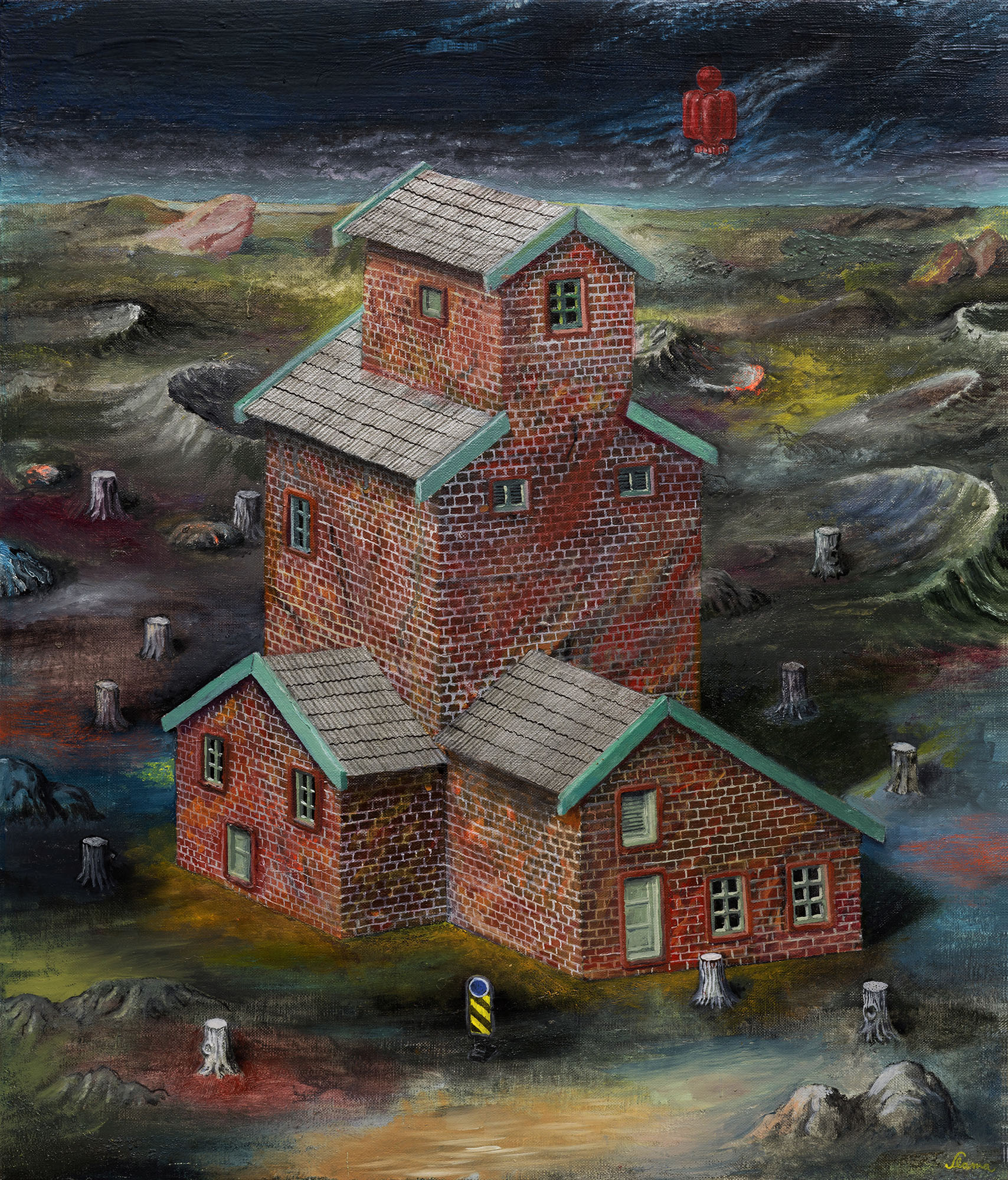
2020 Öl auf Holz / oil on wood 70,2 x 60 cm / 27.6 x 23.6 inches
This 2020 painting harks back to several versions of the same motive, a 2006 drawing, another smaller 2009 drawing, a comparatively large painting from the same year and a later, 2012 re- or overpainting of that painting. It is based on a Heljan plastic model, the Heljan #673 N Scale Meat Packing Plant kit. While painting this iteration of the structure, one of the artist’s roughly four favorite and therefore recurring real world or model-type architectural structures, the artist was grappling with ocular clouding (encroaching blindness) and also with a newly developed (or degenerated) technique of mixing organic substances with oil paint and acrylics, applying the resulting mixture, uneven because of different solubility of its constituents, often in half dried states or different phases of coagulation, onto the canvas with brushes in varying states of distress, interspersing the emerging image with highlights of synthetic luminescent powders and pastes. In this painting the artist perhaps reached a pinnacle in the materialization of a certain style he envisioned – a style where the constant fight between the youthful wish for perfect execution and the cosmic truth of decay leads to its own results, where human mind control and the freedom of molecular motion and chemical interaction coexist, where the Jungian amateur pursuing personal narcissistic goals of alchemical omnipotency finds respite in the struggle between time-bound limitations of the human flesh with the desires of the mind and the phantasy of timelessness.*
*Timelessness of art, which Oskar Kokoschka found perfectly represented in Rembrandt’s “Self-Portrait at the Age of 63” at the National Gallery in London. While bemoaning the bombing of Dresden, visiting the National Gallery at the suggestion of his wife, he found back his inner peace at the contemplation of old skin, “like the skin of a dead chicken”, in the way in which Rembrandt understood to apply his own virtuosity in an inimitably masterful loose yet perfectly controlled application of paint, where molecular structure of the medium and chemical changes taking place in the process of drying and hardening, together with said virtuosity and sheer dexterity of application lead to a lasting and static depiction of a particular stage in a process which in the natural universe leads through life to death and complete disintegration in a matter of only a few years. **
**This anecdote is repeated here not to glorify the artist’s own desires of creating such an effect, but to humble it, as the above painting is not only a very serious effort, but also a typical example of Schlawinertum, as a surrogate to virtuosity and diligence, in contemporary art. It might be even that some hypothetical onlooker would only see the jejune and the would-be where in the eyes of the creator there is at least a glimmer or echo of the inner truth they sought, approached in baby steps which are much too short to reach their goal even within the whole lifetime of a person so encumbered by their own deviant desire for a sorrow-free life, which so often leads in truth to an inordinate accumulation of inner sorrows, often seen and belittled as minor by others, as they are sorrows of the imagination. While someone like Dostojewski, who knew exactly the interaction of sorrows of the imagination and the true sorrow of, for example, hemorrhoids, which so often result from sins of the mind, was so perfectly cognisant of the fact that nobody is entitled to define or judge the difference between imaginary or true sorrow, as their is none in degrees of pain they inflict.
Drawing and text © 2057 by Torsten Slama and the C.O.D





